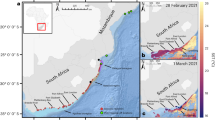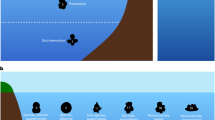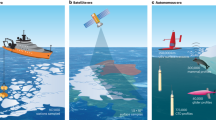Abstract
Ocean acidification results in co-varying inorganic carbon system variables. Of these, an explicit focus on pH and organismal acid–base regulation has failed to distinguish the mechanism of failure in highly sensitive bivalve larvae. With unique chemical manipulations of seawater we show definitively that larval shell development and growth are dependent on seawater saturation state, and not on carbon dioxide partial pressure or pH. Although other physiological processes are affected by pH, mineral saturation state thresholds will be crossed decades to centuries ahead of pH thresholds owing to nonlinear changes in the carbonate system variables as carbon dioxide is added. Our findings were repeatable for two species of bivalve larvae could resolve discrepancies in experimental results, are consistent with a previous model of ocean acidification impacts due to rapid calcification in bivalve larvae, and suggest a fundamental ocean acidification bottleneck at early life-history for some marine keystone species.
This is a preview of subscription content, access via your institution
Access options
Subscribe to this journal
Receive 12 print issues and online access
$209.00 per year
only $17.42 per issue
Buy this article
- Purchase on Springer Link
- Instant access to full article PDF
Prices may be subject to local taxes which are calculated during checkout





Similar content being viewed by others
References
Archer, D., Kheshgi, H. & Maier-Reimer, E. Multiple timescales for neutralization of fossil fuel CO2 . Geophys. Res. Lett. 24, 405–408 (1997).
Hönisch, B. et al. The geological record of ocean acidification. Science 335, 1058–1063 (2012).
Luethi, D. et al. High-resolution carbon dioxide concentration record 650,000–800,000 years before present. Nature 453, 379–382 (2008).
Zeebe, R. E. Seawater pH and isotopic paleotemperatures of Cretaceous oceans. Palaeogeogr. Palaeoclimatol. Palaeoecol. 170, 49–57 (2001).
Waldbusser, G. G. & Salisbury, J. E. Ocean acidification in the coastal zone from an organism’s perspective: Multiple system parameters, frequency domains, and habitats. Ann. Rev. Mar. Sci. 6, 221–247 (2014).
Hendriks, I. E., Duarte, C. M. & Alvarez, M. Vulnerability of marine biodiversity to ocean acidification: A meta-analysis. Estuar. Coast. Shelf Sci. 86, 157–164 (2010).
Parker, L. M. et al. Predicting the response of molluscs to the impact of ocean acidification. Biology 2, 651–692 (2013).
Gazeau, F. et al. Impacts of ocean acidification on marine shelled molluscs. Mar. Biol. 160, 2207–2245 (2013).
Wittmann, A. C. & Poertner, H. O. Sensitivities of extant animal taxa to ocean acidification. Nature Clim. Change 3, 995–1001 (2013).
Kroeker, K. J. et al. Impacts of ocean acidification on marine organisms: Quantifying sensitivities and interaction with warming. Glob. Change Biol. 19, 1884–1896 (2013).
Talmage, S. C. & Gobler, C. J. Effects of past, present, and future ocean carbon dioxide concentrations on the growth and survival of larval shellfish. Proc. Natl Acad. Sci. USA 107, 17246–17251 (2010).
Thomsen, J. et al. Calcifying invertebrates succeed in a naturally CO2-rich coastal habitat but are threatened by high levels of future acidification. Biogeosciences 7, 3879–3891 (2010).
Melzner, F. et al. Food supply and seawater pCO(2) impact calcification and internal shell dissolution in the blue mussel Mytilus edulis. PLoS ONE 6, e24223 (2011).
Shumway, S. E. Effect of salinity fluctuation on the osmotic pressure and Na+, Ca2+, and Mg2+ ion concentrations in the hemolymph of bivalve molluscs. Mar. Biol. 41, 153–177 (1977).
Heinemann, A. et al. Conditions of Mytilus edulis extracellular body fluids and shell composition in a pH-treatment experiment: Acid–base status, trace elements and delta B-11. Geochem. Geophys. Geosyst. 13, Q01005 (2012).
Waldbusser, G. G., Bergschneider, H. & Green, M. A. Size-dependent pH effect on calcification in post-larval hard clam Mercenaria spp. Mar. Ecol. Prog. Ser. 417, 171–182 (2010).
Waldbusser, G. G. et al. A developmental and energetic basis linking larval oyster shell formation to acidification sensitivity. Geophys. Res. Lett. 40, 2171–2176 (2013).
Barton, A., Hales, B., Waldbusser, G. G., Langdon, C. & Feely, R. A. The Pacific oyster, Crassostrea gigas shows negative correlation to naturally elevated carbon dioxide levels: Implications for near-term ocean acidification effects. Limnol. Oceanogr. 57, 698–710 (2012).
Hettinger, A. et al. Persistent carry-over effects of planktonic exposure to ocean acidification in the Olympia oyster. Ecology 93, 2758–2768 (2012).
Hettinger, A. et al. Larval carry-over effects from ocean acidification persist in the natural environment. Glob. Change Biol. 19, 3317–3326 (2013).
Gobler, C. J. & Talmage, S. C. Short and long term consequences of larval stage exposure to constantly and ephemerally elevated carbon dioxide for marine bivalve populations. Biogeosciences 10, 2241–2253 (2013).
Melzner, F. et al. Physiological basis for high CO2 tolerance in marine ectothermic animals: Pre-adaptation through lifestyle and ontogeny? Biogeosciences 6, 2313–2331 (2009).
Michaelidis, B., Ouzounis, C., Paleras, A. & Pörtner, H. O. Effects of long-term moderate hypercapnia on acid–base balance and growth rate in marine mussels Mytilus galloprovincialis. Mar. Ecol. Prog. Ser. 293, 109–118 (2005).
Pörtner, H. O. Ecosystem effects of ocean acidification in times of ocean warming: A physiologist’s view. Mar. Ecol. Prog. Ser. 373, 203–217 (2008).
Madshus, I. H. Regulation of intracellular Ph in eukaryotic cells. Biochem. J. 250, 1–8 (1988).
Walsh, P. J. & Milligan, C. L. Coordination of metabolism and intracellular acid–base status—ionic regulation and metabolic consequences. Can. J. Zool. Rev. Can. Zool. 67, 2994–3004 (1989).
Jury, C. P., Whitehead, R. F. & Szmant, A. M. Effects of variations in carbonate chemistry on the calcification rates of Madracis auretenra (= Madracis mirabilis sensu Wells 1973): Bicarbonate concentrations best predict calcification rates. Glob. Change Biol. 16, 1632–1644 (2010).
Ries, J. B. A physicochemical framework for interpreting the biological calcification response to CO2-induced ocean acidification. Geochim. Cosmochim. Acta 75, 4053–4064 (2011).
Comeau, S., Carpenter, R. C. & Edmunds, P. J Coral reef calcifiers buffer their response to ocean acidification using both bicarbonate and carbonate. Proc. R. Soc. B 280, 1–8 (2013).
Jokiel, P. L. Coral reef calcification: Carbonate, bicarbonate and proton flux under conditions of increasing ocean acidification. Proc. R. Soc. B 280, 1–4 (2013).
Kniprath, E. Ontogeny of the molluscan shell field—a review. Zool. Scr. 10, 61–79 (1981).
Timmins-Schiffman, E., O’Donnell, M. J., Friedman, C. S. & Roberts, S. B. Elevated pCO(2) causes developmental delay in early larval Pacific oysters, Crassostrea gigas. Mar. Biol. 160, 1973–1982 (2013).
Moran, A. L. & Manahan, D. T. Physiological recovery from prolonged ‘starvation’ in larvae of the Pacific oyster Crassostrea gigas. J. Exp. Mar. Biol. Ecol. 306, 17–36 (2004).
Manahan, D. T. & Crisp, D. J. Autoradiographic studies on the uptake of dissolved amino-acids from sea-water by bivalve larvae. J. Mar. Biol. Assoc. UK 63, 673–682 (1983).
Gazeau, F. et al. Effect of carbonate chemistry alteration on the early embryonic development of the Pacific oyster (Crassostrea gigas). PLoS ONE 6, 1–8 (2011).
Bibby, R., Widdicombe, S., Parry, H., Spicer, J. & Pipe, R. Effects of ocean acidification on the immune response of the blue mussel Mytilus edulis. Aquat. Biol. 2, 67–74 (2008).
Gaylord, B. et al. Functional impacts of ocean acidification in an ecologically critical foundation species. J. Exp. Biol. 214, 2586–2594 (2011).
Hauri, C., Gruber, N., McDonnell, A. M. P. & Vogt, M. The intensity, duration, and severity of low aragonite saturation state events on the California continental shelf. Geophys. Res. Lett. 40, 3424–3428 (2013).
Harris, K. E., DeGrandpre, M. D. & Hales, B. Aragonite saturation state dynamics in a coastal upwelling zone. Geophys. Res. Lett. 40, 2720–2725 (2013).
Rumrill, S. S. Natural mortality of marine invertebrate larvae. Ophelia 32, 163–198 (1990).
Ben Kheder, R., Quere, C., Moal, J. & Robert, R. Effect of nutrition on Crassostrea gigas larval development and the evolution of physiological indices Part B: Effects of temporary food deprivation. Aquaculture 308, 174–182 (2010).
Kimmel, D. G. & Newell, R. I. E. The influence of climate variation on Eastern oyster (Crassostrea virginica) juvenile abundance in Chesapeake Bay. Limnol. Oceanogr. 52, 959–965 (2007).
Dumbauld, B. R., Kauffman, B. E., Trimble, A. C. & Ruesink, J. L. The Willapa Bay oyster reserves in Washington state: Fishery collapse, creating a sustainable replacement, and the potential for habitat conservation and restoration. J. Shellfish Res. 30, 71–83 (2011).
Gruber, N. et al. Rapid progression of ocean acidification in the California current system. Science 337, 220–223 (2012).
Feely, R. A., Klinger, T., Newton, J. A. & Chadsey, M. Scientific Summary of Ocean Acidification in Washington State Marine Waters NOAA OAR Special Report No. 3934 (NOAA-OAR 2012)
White, M. M., McCorkle, D. C., Mullineaux, L. S. & Cohen, A. L. Early exposure of Bay Scallops (Argopecten irradians) to high CO2 causes a decrease in larval shell growth. PLoS ONE 8, e61065 (2013).
Bandstra, L., Hales, B. & Takahashi, T. High-frequency measurements of total CO2: Method development and first oceanographic observations. Mar. Chem. 100, 24–38 (2006).
Hales, B., Takahashi, T. & Bandstra, L. Atmospheric CO2 uptake by a coastal upwelling system. Glob. Biogeochem. Cycles 19, GB1009 (2005).
Langdon, C. J., Evans, F., Jacobson, D. & Blouin, M. Yields of cultured Pacific oysters Crassostrea gigas Thunberg improved after one generation of selection. Aquaculture 220, 227–244 (2003).
American Society for Testing and Materials Standard Guide for Conducting Static Acute Toxicity Tests Starting with Embryos of Four Species of Saltwater Bivalve Molluscs E724-98 (ASTM International, 2012)
Acknowledgements
This work was supported by the National Science Foundation OCE CRI-OA #1041267 to G.G.W., B.H., C.J.L. and B.A.H. The authors would like to thank H. Bergschneider, R. Mabardy, J. Sun, G. Hutchinson and T. Klein for their dedicated efforts on the experimental work, S. Smith for sampling and imaging developing embryos, and J. Jennings for assistance and student training on carbonate analyses. G.G.W. would like to specifically thank T. Sawyer in the OSU Electron Microscope Laboratory for guidance on imaging bivalve embryos. Comments from A. Hettinger and S. E. Kolesar improved an earlier version of this manuscript.
Author information
Authors and Affiliations
Contributions
G.G.W., B.H., C.J.L. and B.A.H. conceived and planned the research. G.G.W. designed and supervised experiments. G.G.W. and B.H. analysed data. P.S. organized study components and P.S., M.W.G., E.L.B., I.G. and C.A.M. developed and carried out the experiments. M.W.G., E.L.B., I.G. and C.A.M. analysed organism and chemistry samples. All authors contributed to writing the manuscript.
Corresponding author
Ethics declarations
Competing interests
The authors declare no competing financial interests.
Supplementary information
Rights and permissions
About this article
Cite this article
Waldbusser, G., Hales, B., Langdon, C. et al. Saturation-state sensitivity of marine bivalve larvae to ocean acidification. Nature Clim Change 5, 273–280 (2015). https://doi.org/10.1038/nclimate2479
Received:
Accepted:
Published:
Issue Date:
DOI: https://doi.org/10.1038/nclimate2479
This article is cited by
-
Warming, not acidification, favours survival of non-indigenous over native gammarid species
Biological Invasions (2024)
-
Non-conservative Characteristics of Seawater Calcium Ion in Offshore Aquaculture Areas: A Case Study in the Muping Marine Ranch, Yantai, China
Ocean Science Journal (2023)
-
Spatiotemporal variability of pH in coastal waters of New Brunswick (Canada) and potential consequences for oyster aquaculture
Anthropocene Coasts (2023)
-
First-principle study of Cu-, Ag-, and Au-decorated Si-doped carbon quantum dots (Si@CQD) for CO2 gas sensing efficacies
Journal of Molecular Modeling (2023)
-
Shell thickness of Nucella lapillus in the North Sea increased over the last 130 years despite ocean acidification
Communications Earth & Environment (2022)



